Physical Address
304 North Cardinal St.
Dorchester Center, MA 02124
Physical Address
304 North Cardinal St.
Dorchester Center, MA 02124
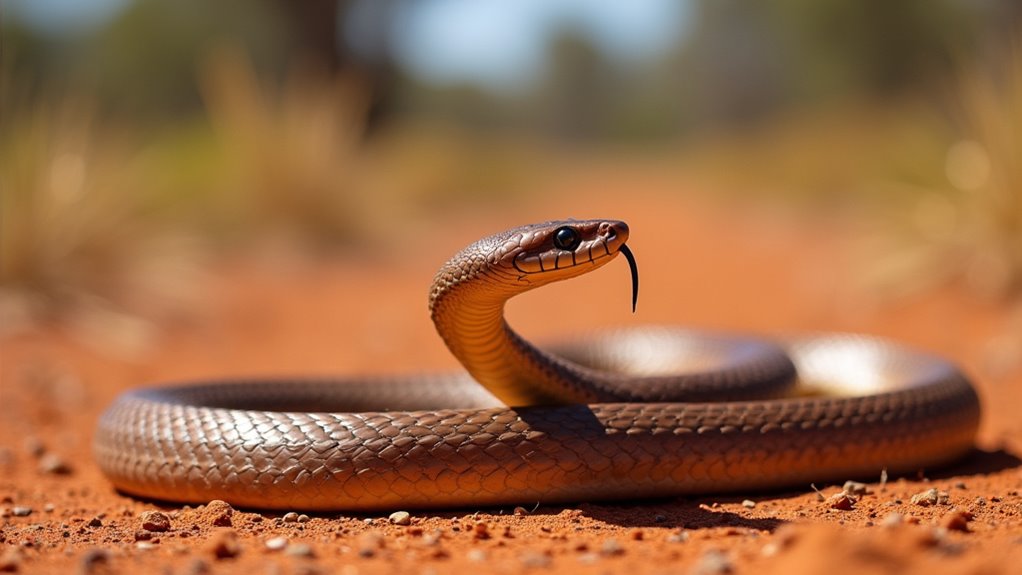
Slithering through Australia's wilderness are deadly serpents that can kill within minutes—which one might you encounter on your next adventure?
Australia hosts the world’s most venomous snakes, including the lethal Inland Taipan, which can kill 100 adults with one bite. You’ll encounter the Eastern Brown Snake most frequently, causing 60% of snakebite deaths. Other deadly species include the Coastal Taipan, Tiger Snake, Mulga Snake, Red-Bellied Black Snake, Western Brown Snake, Copperhead, Dugite, and Yellow-Faced Whip Snake. Knowing these reptiles’ habitats and behaviors could save your life in the outback.
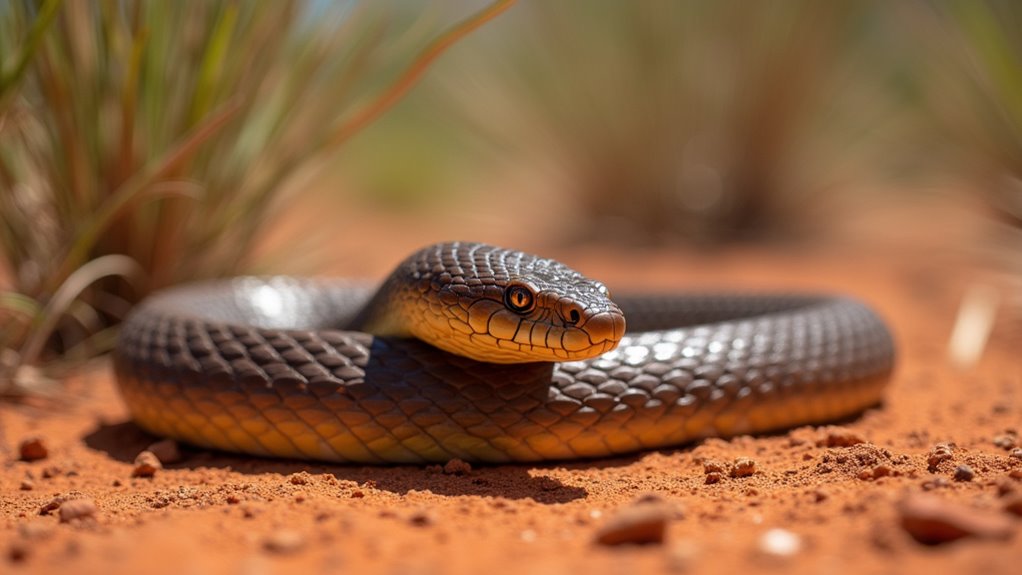
Despite its status as the world’s deadliest snake, the inland taipan rarely poses a threat to humans. Its venom is approximately 50 times more toxic than an Indian cobra’s, with a single bite containing enough toxin to kill 100 adult men.
Deadly but distant, the inland taipan packs enough venom in one bite to kill 100 men.
You’ll find this elusive reptile in Australia’s remote arid regions, where human encounters are exceptionally rare. The inland taipan’s shy, reclusive nature further reduces bite incidents, explaining why there are no recorded human fatalities despite its lethal potential.
When it does bite, the venom rapidly attacks nerve endings, destroys muscle tissue, and causes severe bleeding. Over 80% of bites result in severe envenoming, with an untreated lethality rate exceeding 80%. Also known as the fierce snake, this name refers to its venom potency rather than its temperament.
Australia is home to many deadly snake species that require caution when exploring the outback.
Its short fangs (3.5-6.2mm) deliver an average of 44mg of venom per bite.
While the inland taipan possesses the most potent venom, the Eastern Brown Snake claims the title of Australia’s deadliest snake due to its prevalence in populated areas. It’s responsible for about 60% of snakebite deaths in Australia.
You’ll find this highly adaptable snake throughout eastern Australia, including urban environments. Despite its small 3mm fangs and average 4mg venom yield, just 3mg can be lethal. Their venom contains pseutarin-C complex that rapidly breaks down prothrombin in the blood, leading to severe coagulation disorders.
What makes this snake particularly dangerous is its often painless bite that can lead to death within 4 hours if untreated.
The venom causes progressive paralysis, coagulopathy, and eventually, bleeding complications including cerebral hemorrhage.
The Eastern Brown Snake is commonly found along the east coast of Australia, particularly in regions near Sydney and other populated areas.
If you encounter one, remain calm—they’re generally cautious but can become aggressive when threatened. Always seek immediate medical attention for suspected bites.
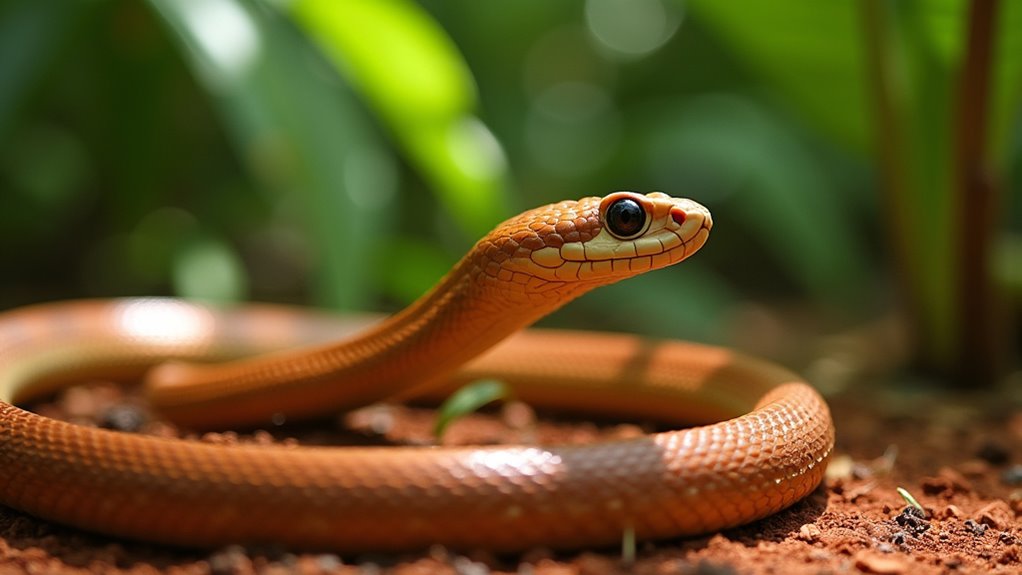
Known for its extraordinary speed and deadly precision, the Coastal Taipan commands respect throughout Australia’s tropical regions. You’ll find these agile hunters in Queensland and northeastern New South Wales, particularly in warm, coastal areas.
The Coastal Taipan moves with lightning speed and lethal accuracy through Australia’s sun-drenched northern shores.
If you encounter a Taipan, you’re facing one of Australia’s most dangerous snakes. When threatened, it inflates its body laterally and raises its forebody in a striking stance, giving its head a distinctive lance-shaped appearance. The snake undergoes a seasonal color change, appearing brighter and more coppery during summer months while becoming darker in winter.
The Taipan delivers multiple rapid bites with remarkable accuracy when cornered. Though preferring to avoid confrontation, it won’t hesitate to defend itself aggressively.
These snakes thrive in various habitats from monsoon forests to sugarcane fields, often sheltering in hollow logs or vegetation piles where they hunt small mammals. Unlike Australia, New Zealand’s ecosystems remain completely free of land snakes, making the Taipan and its relatives unique to the Australian continent.
Across southern Australia’s diverse landscapes, the Tiger Snake has established itself as one of the continent’s most formidable reptiles. You’ll find these distinctive banded snakes from Western Australia to Tasmania, thriving in wetlands, forests, and even urban areas near water sources.
Tiger Snakes primarily feed on frogs but will opportunistically hunt small mammals, birds, and fish. Some populations display complete melanism in cooler regions, absorbing heat more efficiently in high-altitude or island habitats.
While they’re responsible for numerous snakebite incidents in southern Australia, prompt medical treatment with antivenom is highly effective.
If encountered, these defensive snakes may become aggressive when threatened, so maintain a safe distance. Unlike New Zealand’s wildlife, Australia is home to some of the world’s most venomous snakes, making awareness crucial for visitors and residents alike.
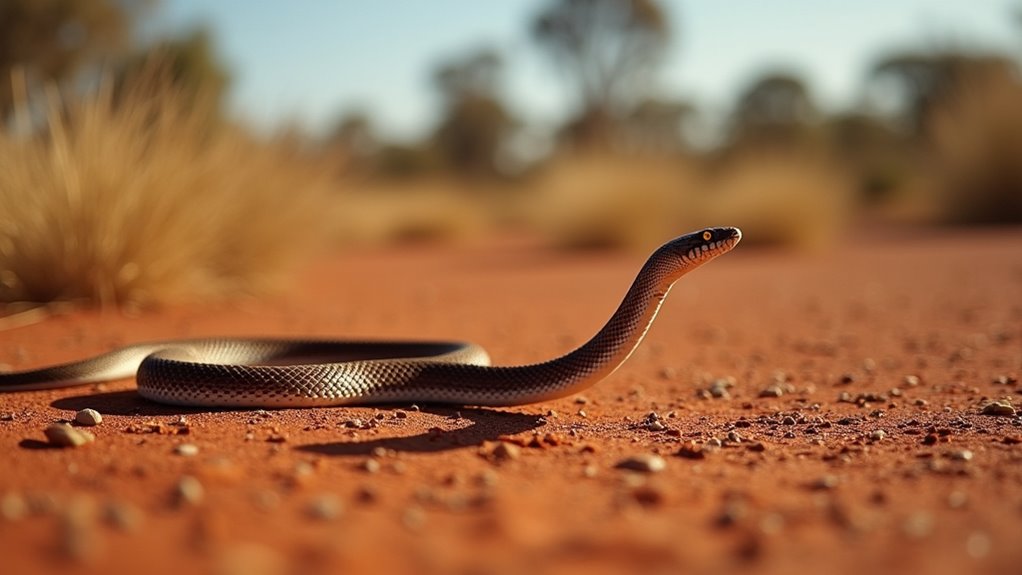
Despite its common name “King Brown,” the Mulga Snake belongs to the black snake family and stands as one of Australia’s most misunderstood venomous reptiles. You’ll find these impressive snakes across most of the continent, adapting to environments from tropical forests to deserts.
Growing between 2-3.3 meters long, they’re among Australia’s largest venomous snakes. Their coloration varies widely from red and copper to brown and black.
While their venom isn’t as potent as other Australian elapids, they compensate by delivering large quantities—up to 150mg per bite.
They’ll eat almost anything they can overpower, including other venomous snakes. Their remarkable diet includes a variety of prey, and they possess immunity to venom from Western Brown Snakes, allowing them to prey on these dangerous reptiles without harm.
Despite their intimidating size, fatal bites are rare due to their cautious nature.
These adaptable predators thrive even in human-altered landscapes. Unlike the cost of living in New Zealand, which varies greatly across regions, Mulga Snakes maintain relatively consistent behavior patterns regardless of their habitat.
Unlike the active-hunting Mulga Snake, the Death Adder has perfected a different deadly strategy. These stout-bodied snakes with triangular heads are ambush predators, lying motionless until prey approaches.
You’ll find them throughout Australia’s eastern and southern coasts, as well as in New Guinea. While exploring these coastal areas, sailors should be aware that Death Adders may inhabit sailing destinations popular with travelers.
What makes Death Adders particularly dangerous:
Unfortunately, Death Adder populations have declined dramatically—nearly 89%—due to cane toad invasions.
These venomous snakes give birth to live young, with females capable of producing up to 24 offspring per litter. The Common Death Adder, scientifically known as Acanthophis antarcticus, is the species exclusively found in the Sydney region among Australian death adders.

Among Australia’s most recognizable venomous snakes, the Red-Bellied Black Snake commands attention with its striking appearance of glossy black scales contrasted by a vibrant crimson underbelly.
You’ll encounter this medium-sized serpent throughout eastern Australia, particularly near water sources. Unlike the deadly spiders of Australia, these snakes generally prefer to avoid human contact.
While its venom contains procoagulants and potential neurotoxins, it’s less toxic than many Australian counterparts. The average venom yield is 37mg, with a maximum recorded at 94mg.
Despite its dangerous reputation, this snake rarely causes human fatalities.
Bites produce swelling, pain, and sometimes anticoagulant coagulopathy. Children face higher risks due to their size.
If you’re exploring eastern Australian bushland, remember these snakes aren’t typically aggressive unless provoked. When threatened, they may exhibit defensive behaviors including spreading the neck, hissing, and mock strikes before attempting to flee.
Black snake or tiger snake antivenom effectively treats envenomation.
The Western Brown Snake poses a formidable threat across mainland Australia, with venom potency ranking among the world’s deadliest serpents. Despite short 2-3mm fangs, they deliver 4-6mg of highly toxic venom per bite.
Australia’s Western Brown Snake delivers deadly venom through small fangs—a potent threat across the mainland.
Their aggressive nature when threatened, combined with their prevalence in populated areas, makes them particularly dangerous. These snakes typically maintain a slender body build with a small head that’s often indistinct from the neck. Unlike tsunamis that primarily threaten coastal regions, these venomous predators can be found in inland areas throughout the country.
When encountering these snakes, be aware of:
If bitten, apply a pressure bandage, immobilize the affected limb, and seek medical help immediately. Prevention is vital—wear protective clothing and avoid tall grass when in Western Brown Snake territory.
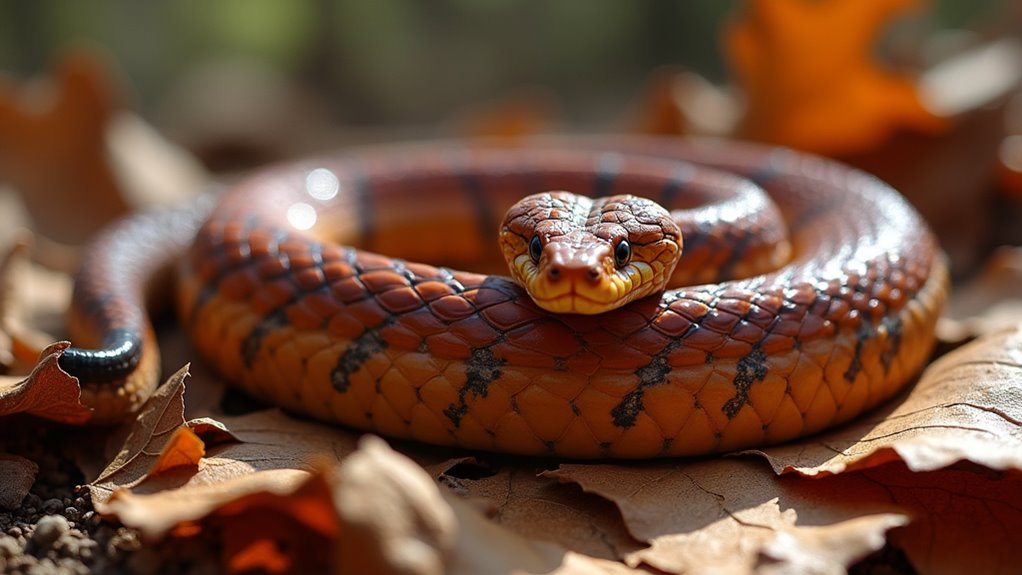
Australia’s Highland Copperhead snake (Austrelaps ramsayi) has adapted remarkably well to cooler climates, making it one of the few venomous species that thrives in alpine and subalpine regions.
You’ll find these medium-sized elapids throughout southeastern Australia, particularly in New South Wales and eastern Victoria.
Distinguished by their copper-colored head and neck, these snakes prefer woodlands and open forests near water sources. They have moderately large eyes with distinctive pale coloration and brown to reddish-brown rims.
They’re often sheltering under fallen timber or in dense vegetation, even in disturbed areas like grazing lands.
Despite being venomous, copperheads are generally inoffensive and reluctant to bite unless provoked.
While not typically life-threatening, their bites require medical attention.
If you’re hiking in highland areas, be cautious near creeks and wetlands where these cold-climate specialists may be found.
Their adaptability to various habitats makes Australia a unique ecological environment compared to snake-free countries like New Zealand.
Feared by Perth residents and respected by herpetologists, dugites (Pseudonaja affinis) rank among Western Australia’s most dangerous serpents in suburban environments. These highly venomous snakes reach up to 2 meters in length and possess semi-glossy grey, green, or brown scales scattered with black markings.
Among Perth’s deadliest residents, dugites command both fear and scientific admiration with their potent venom and adaptability to suburban life.
You’ll most likely encounter dugites in the morning when they’re actively hunting in:
Despite their lethal venom, dugites generally avoid human confrontation unless cornered. They’re remarkable for their adaptability, having successfully colonized golf courses and industrial parks despite heavy human development. They’re primarily active during their breeding season (September to November), when they may become more defensive. Unlike many other venomous species found in Southern Australia, dugites are predominantly found in Perth and other Western Australian regions.
Their diet consists mainly of lizards and mice, though they’re known to be cannibalistic, sometimes consuming other snakes nearly their own size.
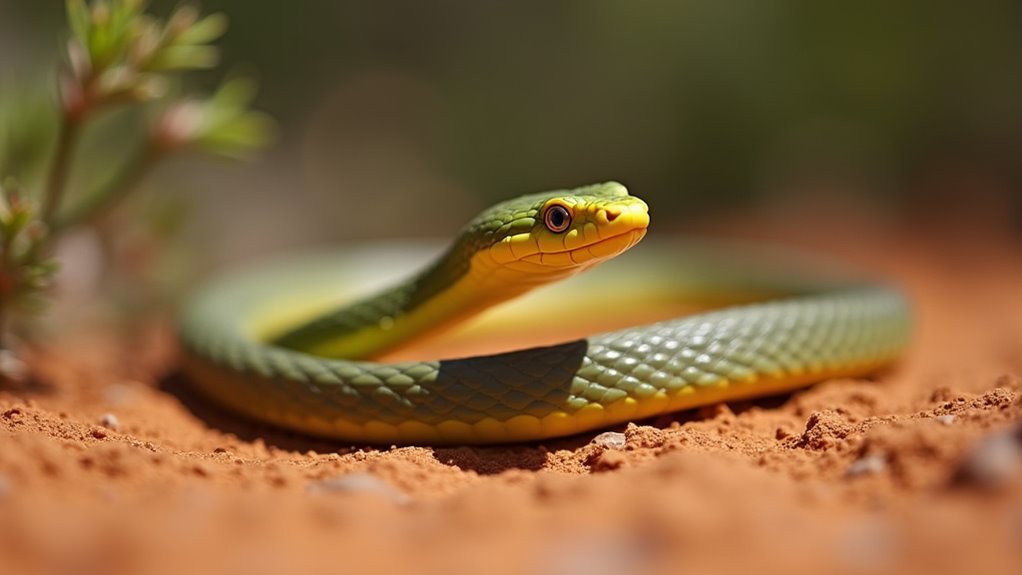
Often mistaken for juvenile brown snakes, Yellow-Faced Whip Snakes (Demansia psammophis) pack a surprisingly potent punch despite their slim build and moderate size of 60-80cm.
Their venom is primarily neurotoxic with haemotoxic components, but poses minimal risk to humans with an LD50 of 2.5 mg/kg in mice.
You’ll find these non-aggressive snakes across Queensland and the Northern Territory in diverse habitats from grasslands to woodlands.
They’re remarkably agile, using their speed to catch small reptiles and escape threats rather than confront them. The snake’s excellent eyesight allows it to effectively chase and capture small diurnal lizards while on the move.
If bitten, you’ll experience localized pain and swelling, possibly mild nausea or headaches.
While symptoms typically resolve within 48 hours, seek medical attention to rule out misidentification or complications.
For pets, especially cats, bites require immediate veterinary care.
You’ve now explored Australia’s most venomous snakes, each capable of delivering potent toxins that can kill within hours. As you’re hiking tomorrow through bushland, you’ll notice these same patterns and habitats we’ve discussed. Remember, these snakes don’t seek encounters—they’re simply surviving. Keep your distance, wear proper footwear, and stay alert. It’s no coincidence that awareness and respect are your best defenses against Australia’s slithering dangers.